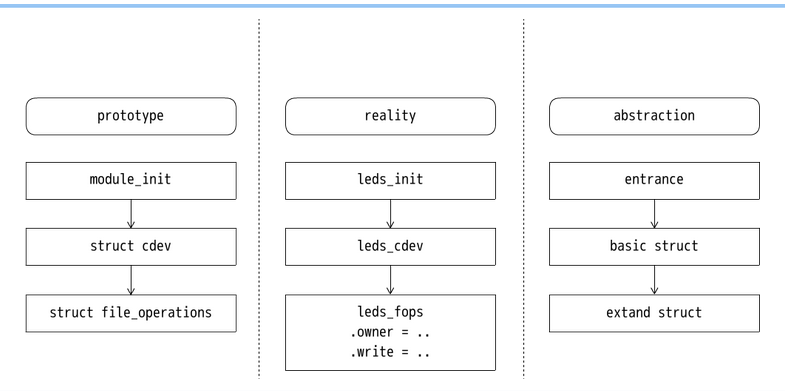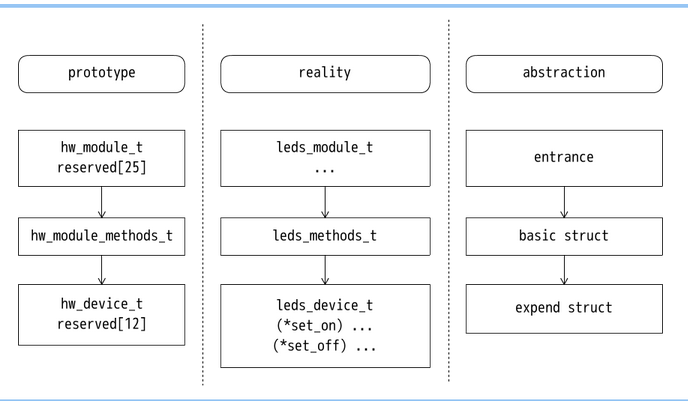ok6410 android driver(11)
This essay, I go to a deeply studying to android HAL device driver program.
According to the android architecture we disscus in last essay, when we are designing a android device driver, we should follow the steps below :
(1) linux device driver
In this driver, we should try our best to cut down the mechanism and change them to be more concise.
(2) HAL libraries
The HAL serves as a standard interface that allows the Android system to call into the device driver layer while being agnostic about the lower-level implementations of your drivers and hardware.
(3)Service libraries
System service access the hardware in HAL libraries and provide the APIs for android framework. Service libraries usually are JNI libraries or Linux libraries.
1、linux device driver
//s3c6410_leds_hal.c
#include <linux/fs.h>
#include <linux/cdev.h>
#include <linux/pci.h>
#include <asm/uaccess.h>
#include <mach/map.h>
#include <mach/regs-gpio.h>
#include <mach/gpio-bank-m.h> #define DEVICE_NAME "s3c6410_leds_hal"
#define DEVICE_COUNT 1
#define S3C6410_LEDS_MAJOR 0
#define S3C6410_LEDS_MINOR 234 static unsigned char mem[];
static int major = S3C6410_LEDS_MAJOR;
static int minor = S3C6410_LEDS_MINOR;
static dev_t leds_number;
static struct class *leds_class = NULL; static void write_io(unsigned char buf[])
{
int i;
unsigned int tmp;
tmp = ioread32(S3C64XX_GPMDAT);
for (i = ; i < ; i++) {
if (buf[i] == '') {
tmp &= (~( << i));
} else {
tmp |= ( << i);
}
}
iowrite32(tmp, S3C64XX_GPMDAT);
} static ssize_t s3c6410_leds_hal_write(struct file *filp,
const char __user *buf, size_t count, loff_t *ppos)
{
unsigned int tmp = count; if (count > ) {
tmp = ;
} if (copy_from_user(mem, buf, tmp)) {
return -EFAULT;
} else {
write_io(mem);
}
return count;
} static struct file_operations leds_fops = {
.owner = THIS_MODULE,
.write = s3c6410_leds_hal_write,
};
static struct cdev leds_cdev; static int leds_create_device(void)
{
int ret = ;
int err = ; cdev_init(&leds_cdev, &leds_fops);
leds_cdev.owner = THIS_MODULE;
if (major > ) {
leds_number = MKDEV(major, minor);
err = register_chrdev_region(leds_number, DEVICE_COUNT, DEVICE_NAME);
if (err < ) {
printk(KERN_WARNING "register_chardev_region() failed.\n");
return err;
}
} else {
err = alloc_chrdev_region(&leds_cdev.dev, ,
DEVICE_COUNT, DEVICE_NAME);
if (err < ) {
printk(KERN_WARNING "register_chardev_region() failed.\n");
return err;
}
major = MAJOR(leds_cdev.dev);
minor = MINOR(leds_cdev.dev);
leds_number = leds_cdev.dev;
} ret = cdev_add(&leds_cdev, leds_number, DEVICE_COUNT);
leds_class = class_create(THIS_MODULE, DEVICE_NAME);
device_create(leds_class, NULL, leds_number, NULL, DEVICE_NAME);
return ret; } static int leds_init(void)
{
int ret;
ret = leds_create_device();
printk(DEVICE_NAME "\tinitialized.\n"); return ret;
} static void leds_exit(void) {
device_destroy(leds_class, leds_number);
if (leds_class) {
unregister_chrdev_region(leds_number, DEVICE_COUNT);
return;
}
printk(DEVICE_NAME"\texit.\n");
} module_init(leds_init);
module_exit(leds_exit); MODULE_LICENSE("GPL");
Yes, this file is the same as the previous driver file, because there aren't any business-related codes in this simple led driver.
Then we focus more in the HAL libraries and Service libraries coding.
2、HAL libraries
HAL modules would be compile to a Linux shared library (*.so), and these *.so files could be automaticlly loaded by android system.
Each HAL module should provide a variable for android system loading : HAL_MODULE_INFO_SYM (never change it.)
//Android.mk
LOCAL_PATH := $(call my-dir)
include $(CLEAR_VARS) LOCAL_PRELINK_MODULE := false
LOCAL_MODULE_PATH := $(TARGET_OUT_SHARED_LIBRARIES)/hw
LOCAL_SHARED_LIBRARIES := liblog
LOCAL_SRC_FILES := leds_hal.c
LOCAL_MODULE := leds_hal.default
LOCAL_MODULE_TAGS := eng
include $(BUILD_SHARED_LIBRARY) //leds_hal.h
#include <hardware/hardware.h>
#include <fcntl.h>
#include <cutils/log.h> struct leds_module_t {
struct hw_module_t hw_module;
}; struct leds_device_t {
struct hw_device_t hw_device;
int (*set_on)(struct leds_device_t *dev, int32_t led);
int (*set_off)(struct leds_device_t *dev, int32_t led);
}; #define LED_HARDWARE_MODULE_ID "leds_hal"
//leds_hal.c
#include "leds_hal.h" int fd_leds = ; int leds_switch(struct leds_device_t *dev, int32_t led, int32_t on_off)
{
unsigned char buf[]; if (led < && led > ) {
LOGI("Led Stub : no this led.\n");
return -;
} if (on_off == ) {
LOGI("Led Stub : set %d led on", led);
buf[led] = '';
} else {
LOGI("Led Stub : set %d led off", led);
buf[led] = '';
} write(fd_leds, buf, );
return ;
} int leds_on(struct leds_device_t *dev, int32_t led)
{
return leds_switch(dev, led, );
} int leds_off(struct leds_device_t *dev, int32_t led)
{
return leds_switch(dev, led, );
} int leds_device_close(struct hw_device_t *device)
{
struct leds_device_t *ldt = (struct leds_device_t *) device; if (ldt)
free(ldt); close(fd_leds);
return ;
} static int leds_device_open(const struct hw_module_t *module, const char *name,
struct hw_device_t **device)
{
struct leds_device_t *leds_dev;
leds_dev = (struct leds_device_t *) malloc(sizeof(*leds_dev)); memset(leds_dev, , sizeof(*leds_dev)); leds_dev->hw_device.tag = HARDWARE_DEVICE_TAG;
leds_dev->hw_device.version = ;
leds_dev->hw_device.module = (struct hw_module_t *) module;
leds_dev->hw_device.close = leds_device_close;
leds_dev->set_on = leds_on;
leds_dev->set_off = leds_off; *device = (hw_device_t *) leds_dev; fd_leds = open("/dev/s3c6410_leds_hal", O_RDWR); if (fd_leds < ) {
LOGI("Led Stub : open /dev/s3c6410_leds_hal fail.\n");
} else {
LOGI("Led Stub : open /dev/s3c6410_leds_hal success.\n");
} return ;
} static struct hw_module_methods_t leds_module_methods = {
.open = leds_device_open
}; struct leds_module_t HAL_MODULE_INFO_SYM = {
hw_module : {
tag: HARDWARE_MODULE_TAG,
version_major: ,
version_minor: ,
id: LED_HARDWARE_MODULE_ID,
name: "Led HAL Stub",
methods: &leds_module_methods,
}
};
Acturely, in this simple leds HAL module, we didn't get much messages about "business-related", but we can treat the leds switch functions as.
And the more important messages we need to know are listing follow :
HAL_MODULE_INFO_SYM
hw_module_t
hw_device_t
hw_module_methods_t
Ok, let's stop here. I wanna to talk some more about the module both in linux and android.
In my opnions, there are a lot of design logic share with this two system.
(1) linux

In the picture, we can see what we should do to design a device driver :
Create a entrance function;
Declare a basic struct;
Extand the struct with special operations.
(2) android

In the picture, we can see the android HAL is the same as linux device driver in the three absractions :
Entrance, basic struct, expend struct.
Then I will discuss the different between the two system ;
[ Entrance ]
// We use functions to build the device driver in linux
module_init(leds_init); // The entrance is a variable HAL_MODULE_INFO_SYM automaticlly loaded by the system
struct leds_module_t HAL_MODULE_INFO_SYM = {
hw_module : {
tag: HARDWARE_MODULE_TAG,
version_major: ,
version_minor: ,
id: LED_HARDWARE_MODULE_ID,
name: "Led HAL Stub",
methods: &leds_module_methods,
}
};
[ Basic Struct ]
// Basic struct in linux is a structure, we use the "struct" to create our device
static struct cdev leds_cdev; // Basic struct in android is a structure with function open, we use the "function" to create our device
static int leds_device_open(const struct hw_module_t *module, const char *name,
struct hw_device_t **device)
{
struct leds_device_t *leds_dev;
leds_dev = (struct leds_device_t *) malloc(sizeof(*leds_dev)); memset(leds_dev, , sizeof(*leds_dev)); leds_dev->hw_device.tag = HARDWARE_DEVICE_TAG;
leds_dev->hw_device.version = ;
leds_dev->hw_device.module = (struct hw_module_t *) module;
leds_dev->hw_device.close = leds_device_close;
leds_dev->set_on = leds_on;
leds_dev->set_off = leds_off; *device = (hw_device_t *) leds_dev; fd_leds = open("/dev/s3c6410_leds_hal", O_RDWR); if (fd_leds < ) {
LOGI("Led Stub : open /dev/s3c6410_leds_hal fail.\n");
} else {
LOGI("Led Stub : open /dev/s3c6410_leds_hal success.\n");
} return ;
}
[ Extend Struct ]
// The extend struct means the functions include in file_operations, we have to build the callback functions in linux.
static struct file_operations leds_fops = {
.owner = THIS_MODULE,
.write = s3c6410_leds_hal_write,
}; // Instead of using the prototype, the HAL specification suggest us to create two new struct with the first element hw_module_t/hw_device_t in android.
// We can see that it is useless to create a struct in a prototype to hw_device_t, because there is no callback functions in this struct.
// If we want to extend the hw_device_t, we should create the new struct as the substruct of hw_device_t
struct leds_device_t {
struct hw_device_t hw_device;
int (*set_on)(struct leds_device_t *dev, int32_t led);
int (*set_off)(struct leds_device_t *dev, int32_t led);
};
After compiling, we should push the leds_hal.default.so to dir /system/lib/hw in ok6410.
I will discuss the "Service libraries" in next essay.
ok6410 android driver(11)的更多相关文章
- ok6410 android driver(5)
Test the android driver by JNI (Java Native Interface), In the third article, we know how to compile ...
- ok6410 android driver(9)
In this essay, I will write the JNI to test our leds device. If you don't know how to create a jni p ...
- ok6410 android driver(8)
In the past, we know how to create and run a simple character device driver on pc, goldfish and ok64 ...
- ok6410 android driver(3)
This article discusses the Makefile and how to port the module to different platform (localhost and ...
- ok6410 android driver(12)
In this essay, I will talk about how to write the service libraries. TIPS : I won't discuss the name ...
- ok6410 android driver(10)
From this essay, we go to a new discussion "Android Hardware Abstraction Layer". In this e ...
- ok6410 android driver(7)
This article talk about how to test device driver on JNI. There are two ways to test the device driv ...
- ok6410 android driver(6)
This is a short essay about the mistakes in compiling ok6410 android-2.3 source codes. If there is n ...
- ok6410 android driver(1)
target system : Android (OK6410) host system : Debian Wheezy AMD64 1.Set up android system in ok6410 ...
随机推荐
- pgpgin|pgpgout|pswpin|pswpout意义与差异
引用来自: http://ssms.cs2c.com.cn/otrs/pc.pl?Action=PublicFAQZoom;ItemID=11741 文章主要意思是: 1. page in/out操作 ...
- mac OSX 上 brew install hive
本文介绍brew install hive并修改默认的metastore存储方案,改Derby数据库为mysql的方法以及可能遇到的问题的解决方案. 1. 通过homebrew安装hive 1 bre ...
- eclipse连接远程hadoop集群开发时权限不足问题解决方案
转自:http://blog.csdn.net/shan9liang/article/details/9734693 eclipse连接远程hadoop集群开发时报错 Exception in t ...
- Navi.Soft30.框架.Mobile.开发手册
1概述 1.1应用场景 互联网的发展,使用基于Web的软件异军突起,目前占据着相当大的市场份额,而手机,平板电脑等移动端设备的频繁使用,使移动端的软件快速发展,逐步有超越Web软件的趋势 移动软件中, ...
- CSS3学习笔记--transform中的Matrix(矩阵)
transform: matrix(a,b,c,d,e,f) ,如下图矩阵所示,任意点(x,y,1)经过matrix变化为(ax+cy+e,bx+dy+f,1),由此可以知道,matrix参数与tra ...
- [AX2012]Report data provider调试
运行使用RDP作为数据源的报表时,RDP类被编译成.NET的服务调用,RDP是X++的代码,它的调试是在MorphX调试器中完成.要在MorphX调试器中调试RDP的X++代码需要以下配置: 添加AO ...
- Web GIS 离线地图
Web GIS 离线地图 1,基于瓦片的离线地图下载 博客园 阿凡卢 提供了离线地图的下载工具,下载地址:http://pan.baidu.com/s/1hqvQr7e 具体使用见 参考资料2 阿凡卢 ...
- Request is not available in this context
部署到新服务器的IIS的时候发现这个错误: Request is not available in this context 解决方案: <system.web> <customEr ...
- 使用pathogen管理Vim插件并托管到Github
参照文章[1][2]的办法,将vim打造成一个Python开发环境.文章中使用的是 pathogen + git 来管理 Vim 插件的.对这种方式还不太明白的同学可以参考[3]中的介绍.pathog ...
- 使用Eclipse PDT + Xampp搭建Php开发环境
最新文章:Virson's Blog Eclipse版本:Eclipse Luna Service Release 2 (4.4.2) Xampp版本:XAMPP for Windows 5.6.8 ...
